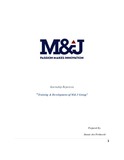| dc.contributor.advisor | Siddiqui, Sayla Sowat | |
| dc.contributor.author | Ferdawshi, Jannat Ara | |
| dc.date.accessioned | 2016-09-27T04:09:09Z | |
| dc.date.available | 2016-09-27T04:09:09Z | |
| dc.date.copyright | 2016 | |
| dc.date.issued | 2016-06-07 | |
| dc.identifier.other | ID 11204062 | |
| dc.identifier.uri | http://hdl.handle.net/10361/6469 | |
| dc.description | This internship report is submitted in a partial fulfillment of the requirements for the degree of Bachelor of Business Administration, 2016. | en_US |
| dc.description | Cataloged from PDF version of Internship report. | |
| dc.description | Includes bibliographical references (page 58-59). | |
| dc.description.abstract | Every organization needs to have well trained and experienced people to perform the activities
that have to be done. If current or potential occupents can meet these requirements, Training is
not important. On the other hand, if this is not the caae, it is necessary to raise the skill levels
and increase the versitility and adoptability of the employees. Moreover, employees are the
internal assets of an organization. Training presents a prime opportunity to expand the
knowledge base of all employees so that they can relate those training with their workplace and
give their best performance achieving company goals. Knowledge and skills development is
vital to the health of organizations. We live in an information age today and organizations are
routinely valued not just on their physical but on their intellectual capital. Training is one of the
chief methods of maintaining and improving intellectual capital, so the quality of an
organization’s training affects its value. Untrained or poorly trained employees cost significantly
more to support than well-trained employees do. Training affects employee retention and is
valuable commodities that, if viewed as an investment rather than as an expense, can produce high returns. Employees also miss out on work time while attending training sessions, which
may delay the completion of projects. Despite the potential drawbacks, training and development
provides both the company as a whole and the individual employees with benefits that make the
cost and time a worthwhile investment.
This report is based on the Training of M&J Group, a leading garments business established in
the year 1965 as a flour mill, later on expanded business and now we are working on the
garments sector of this company. This report consists of the overall HR practices, such asrecruitment
and selection, training and development, performance management, staffing etc. It
also mentions how the company is developing strategic human resource practices along with
their business strategies. Additionally, it provides the outcomes of evolving role of strategic HR
instead of traditional HR practices in the organization. We found out that M&J Group mostly
follows strategic HR practices.
On the report we mentioned all the information we gathered regarding the company and its
various HR practices, and came up with some analysis of our own. We also tried to provide some
recommendations to the company with our own and limited knowledge and experience on
SHRM. Finally, the report is based on the combination of the SHRM of M&J Group and also our
analysis on the factors concerning their procedures regarding HR. | en_US |
| dc.description.statementofresponsibility | Jannat Ara Ferdawshi | |
| dc.format.extent | 60 pages | |
| dc.language.iso | en | en_US |
| dc.publisher | BRAC University | en_US |
| dc.rights | BRAC University Internship reports are protected by copyright. They may be viewed from this source for any purpose, but reproduction or distribution in any format is prohibited without written permission. | |
| dc.subject | M&J Group | en_US |
| dc.subject | Training | en_US |
| dc.title | Training & development of M&J Group | en_US |
| dc.type | Internship report | en_US |
| dc.contributor.department | BRAC Business School, BRAC University | |
| dc.description.degree | B. Business Administration | |

